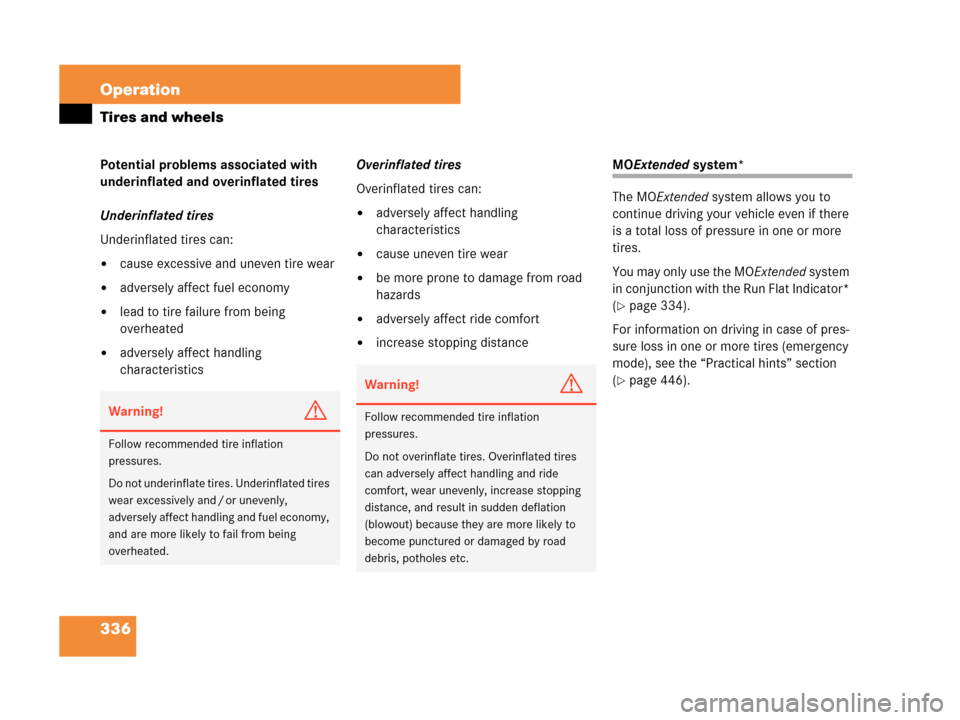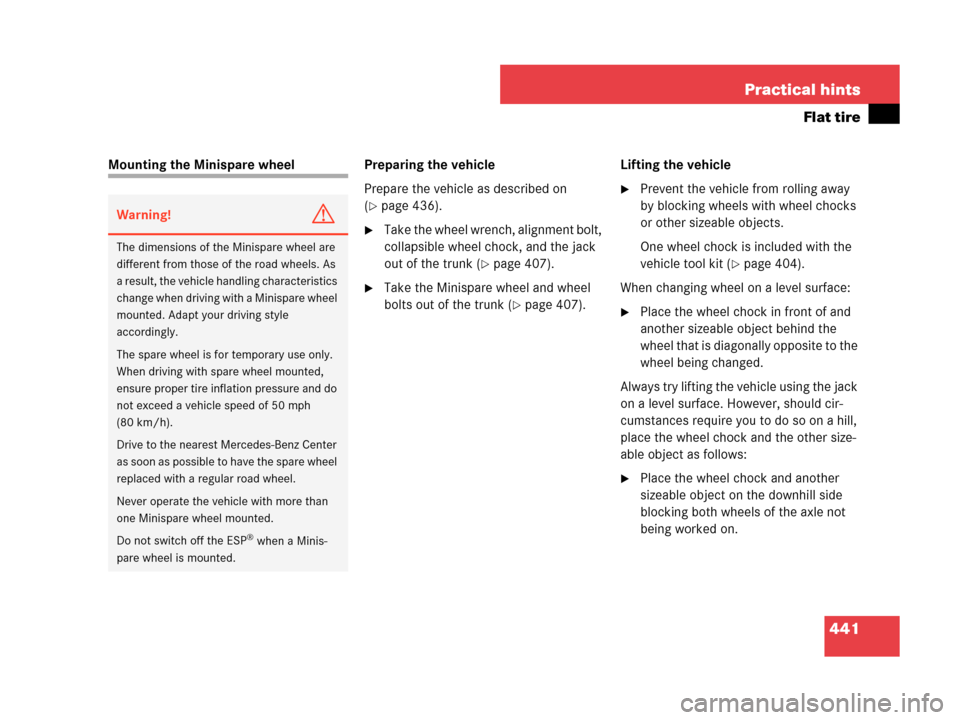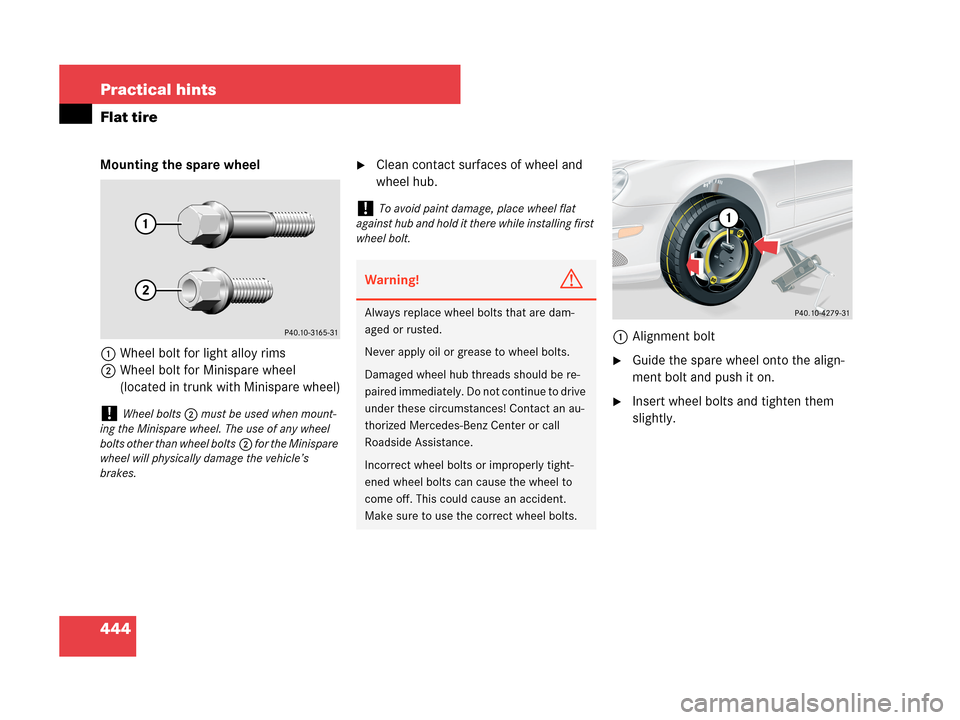Page 337 of 505

336 Operation
Tires and wheels
Potential problems associated with
underinflated and overinflated tires
Underinflated tires
Underinflated tires can:
�cause excessive and uneven tire wear
�adversely affect fuel economy
�lead to tire failure from being
overheated
�adversely affect handling
characteristicsOverinflated tires
Overinflated tires can:
�adversely affect handling
characteristics
�cause uneven tire wear
�be more prone to damage from road
hazards
�adversely affect ride comfort
�increase stopping distance
MOExtended system*
The MOExtended system allows you to
continue driving your vehicle even if there
is a total loss of pressure in one or more
tires.
You may only use the MOExtended system
in conjunction with the Run Flat Indicator*
(
�page 334).
For information on driving in case of pres-
sure loss in one or more tires (emergency
mode), see the “Practical hints” section
(
�page 446).
Warning!G
Follow recommended tire inflation
pressures.
Do not underinflate tires. Underinflated tires
wear excessively and / or unevenly,
adversely affect handling and fuel economy,
and are more likely to fail from being
overheated.
Warning!G
Follow recommended tire inflation
pressures.
Do not overinflate tires. Overinflated tires
can adversely affect handling and ride
comfort, wear unevenly, increase stopping
distance, and result in sudden deflation
(blowout) because they are more likely to
become punctured or damaged by road
debris, potholes etc.
Page 388 of 505

387 Practical hints
What to do if …?
Display messagePossible cause/consequencePossible solution
Run Flat Indicator
inactiveRun Flat Indicator* is malfunctioning
or has been switched off due to an
error.�Have the Run Flat Indicator* checked by an autho-
rized Mercedes-Benz Center.
Check tires
Then reactivate
Run Flat IndicatorThere was a warning message about a
loss in the tire inflation pressure and
the Run Flat Indicator* has not been
reactivated yet.�Make sure that the correct tire inflation pressure is
set for each tire.
�Then reactivate the Run Flat Indicator*.
Tire pressure
Check tiresThe Run Flat Indicator* indicates that
the pressure is too low in one or more
tires.�Carefully bring the vehicle to a halt, avoiding
abrupt steering and braking maneuvers. Observe
the traffic situation around you.
�Check and adjust tire inflation pressure as
required (
�page 333).
�If necessary, change the wheel (�page 436).
�Reactivate the Run Flat Indicator* after adjusting
the tire inflation pressure values (
�page 335).
Warning!G
Do not drive with a flat tire. A flat tire affects
the ability to steer or brake the vehicle.
You may lose control of the vehicle. Contin-
ued driving with a flat tire will cause exces-
sive heat build-up and possibly a fire.
Page 410 of 505
409 Practical hints
Where will I find...?
In case of a flat tire, you may temporarily
use the Minispare wheel when observing
the following restrictions:
�Do not exceed a vehicle speed of
50 mph (80 km/h).
�Drive to the nearest tire repair facility
to have the flat tire repaired or
replaced as appropriate.
�Do not operate vehicle with more than
one Minispare wheel mounted.
For more information, see “Rims and tires”
(
�page 466).
Spare wheel bolts
The spare wheel bolts are fixed at the
Minispare wheel.
1Wheel bolt for light alloy rims
2Wheel bolt for Minispare wheel
(located in trunk with spare wheel)!Wheel bolts2 must be used when mount-
ing the Minispare wheel. The use of any wheel
bolts other than wheel bolts2 for the Minispare
wheel will physically damage the vehicle’s
brakes.
Warning!G
Make sure to use the original length wheel
bolts when remounting the original wheel
after it has been repaired.
Page 438 of 505

437 Practical hints
Flat tire
�Foreign objects (e.g. screws or nails)
should not be removed from the tire.
�Take TIREFIT, the sticker, and the
electric air pump out of the trunk
(
�page 404).
�Attach the sticker (supplied with the
TIREFIT kit) where it will be easily seen
by the driver on the instrument cluster.1TIREFIT container
2Flap
3Notch
4Electrical plug
5Air hose
6Flange
�Open flap2 on the electric air pump.
�Pull electrical plug4 and air hose5
out of the pump housing.
Warning!G
TIREFIT is a limited repair device. TIREFIT
cannot be used for cuts or punctures larger
than approximately 0.16 in (4 mm) and tire
damage caused by driving with extremely
low tire inflation pressure, or on a flat tire, or
a damaged wheel.
Do not drive the vehicle under such circum-
stances.
Contact your nearest Mercedes-Benz
Center for assistance or call Roadside
Assistance.
Warning!G
Take care not to allow the contents of
TIREFIT to come in contact with hair, eyes or
clothing. TIREFIT is harmful if inhaled,
swallowed or absorbed through the skin -
causes skin, eye and respiratory irritation.
Any contact with eyes or skin should be
flushed immediately with plenty of water.
If clothing comes in contact with TIREFIT,
change clothing as soon as possible.
In case of allergic reaction or rash, consult a
physician immediately.
Warning!G
Keep TIREFIT out of reach of children.
If swallowed, rinse mouth immediately with
plenty of water and drink plenty of water.
Do not induce vomiting!
Consult a physician immediately.
Keep away from open flame or heat source.
iIf sealant has leaked out, let it dry. You can
then peel it off.
��
Page 440 of 505

439 Practical hints
Flat tire
�After attaining a tire inflation pressure
of 26 psi (1.8 bar), press0 on electric
air pump switch8.
The electric air pump should now be
switched off.
�Turn the SmartKey in the starter switch
to position0 (
�page 36).
Vehicles with KEYLESS-GO*:
�Press the KEYLESS-GO* start/stop
button (
�page 37) on the gear
selector lever twice. Do not depress
brake pedal.
�Detach the electric air pump.
The air hose may still be hot. Please
exercise appropriate caution.
�Place the electrical air pump back in
the trunk.
�Close the trunk lid.
�Drive away immediately.
The TIREFIT sealant will distribute itself
evenly inside the tire.
�After driving the vehicle for an initial
10 minutes, check the tire inflation
pressure using pressure gauge 9 on
the air pump.
Warning!G
If a tire inflation pressure of 26 psi (1.8 bar)
is not attained, tire is too severely damaged
for TIREFIT to provide a reliable tire repair.
In this case, TIREFIT cannot properly seal
the tire.
Do not drive the vehicle.
Contact the nearest Mercedes-Benz Center
or call Roadside Assistance.
Warning!G
Do not exceed vehicle speed of
50 mph (80 km / h). A TIREFIT repair is not
designed to operate at higher speeds.
The sticker supplied with the TIREFIT kit
must be attached on the instrument cluster
where it will be easily seen by the driver.
Vehicle handling characteristics may
change. Adapt your driving accordingly.
��
Page 442 of 505

441 Practical hints
Flat tire
Mounting the Minispare wheel Preparing the vehicle
Prepare the vehicle as described on
(
�page 436).
�Take the wheel wrench, alignment bolt,
collapsible wheel chock, and the jack
out of the trunk (
�page 407).
�Take the Minispare wheel and wheel
bolts out of the trunk (
�page 407).Lifting the vehicle
�Prevent the vehicle from rolling away
by blocking wheels with wheel chocks
or other sizeable objects.
One wheel chock is included with the
vehicle tool kit (
�page 404).
When changing wheel on a level surface:
�Place the wheel chock in front of and
another sizeable object behind the
wheel that is diagonally opposite to the
wheel being changed.
Always try lifting the vehicle using the jack
on a level surface. However, should cir-
cumstances require you to do so on a hill,
place the wheel chock and the other size-
able object as follows:
�Place the wheel chock and another
sizeable object on the downhill side
blocking both wheels of the axle not
being worked on.
Warning!G
The dimensions of the Minispare wheel are
different from those of the road wheels. As
a result, the vehicle handling characteristics
change when driving with a Minispare wheel
mounted. Adapt your driving style
accordingly.
The spare wheel is for temporary use only.
When driving with spare wheel mounted,
ensure proper tire inflation pressure and do
not exceed a vehicle speed of 50 mph
(80 km/h).
Drive to the nearest Mercedes-Benz Center
as soon as possible to have the spare wheel
replaced with a regular road wheel.
Never operate the vehicle with more than
one Minispare wheel mounted.
Do not switch off the ESP
® when a Minis-
pare wheel is mounted.
Page 445 of 505

444 Practical hints
Flat tire
Mounting the spare wheel
1Wheel bolt for light alloy rims
2Wheel bolt for Minispare wheel
(located in trunk with Minispare wheel)�Clean contact surfaces of wheel and
wheel hub.
1Alignment bolt
�Guide the spare wheel onto the align-
ment bolt and push it on.
�Insert wheel bolts and tighten them
slightly.!Wheel bolts2 must be used when mount-
ing the Minispare wheel. The use of any wheel
bolts other than wheel bolts2 for the Minispare
wheel will physically damage the vehicle’s
brakes.
!To avoid paint damage, place wheel flat
against hub and hold it there while installing first
wheel bolt.
Warning!G
Always replace wheel bolts that are dam-
aged or rusted.
Never apply oil or grease to wheel bolts.
Damaged wheel hub threads should be re-
paired immediately. Do not continue to drive
under these circumstances! Contact an au-
thorized Mercedes-Benz Center or call
Roadside Assistance.
Incorrect wheel bolts or improperly tight-
ened wheel bolts can cause the wheel to
come off. This could cause an accident.
Make sure to use the correct wheel bolts.
Page 446 of 505
445 Practical hints
Flat tire
�Unscrew the alignment bolt, install last
wheel bolt and tighten slightly.Lowering the vehicle
�Lower vehicle by turning crank coun-
terclockwise until the full weight of the
vehicle is resting on the ground.
�Remove the jack.
1 - 5 Wheel bolts
�Tighten the five wheel bolts evenly,
following the diagonal sequence
illustrated (1 to 5), until all bolts are
tight. Observe a tightening torque
of 80 lb-ft (110 Nm).Before storing the jack, it should be fully
collapsed, with handle folded in (storage
position) (
�page 406).
�Store the jack and the other vehicle
tools in the trunk.
Warning!G
Only use Genuine equipment
Mercedes-Benz wheel bolts. Other wheel
bolts may come loose.
Do not tighten the wheel bolts when the ve-
hicle is raised. Otherwise the vehicle could
fall off the jack.
Warning!G
Have the tightening torque checked after
changing a wheel. The wheels could come
loose if they are not tightened to a torque of
80 lb-ft (110 Nm).